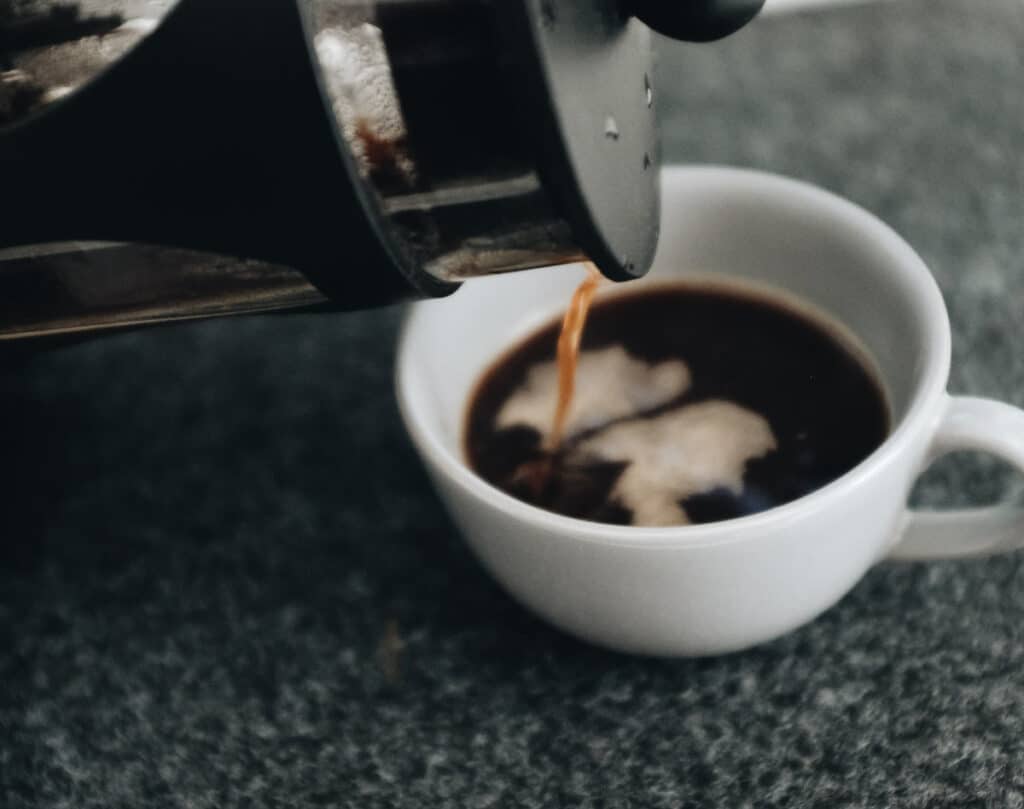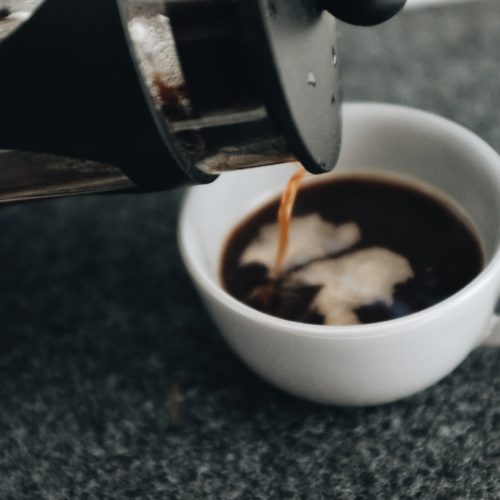Do you love the dark intensity and hit of an espresso? Or maybe you want to make an americano or cappuccino or mocha or latte or (well the list goes on). Somewhere along the line, you will really want to enjoy your favorite espresso-based drink at home. But here’s the thing, what do you do if you don’t own an espresso machine? The answer is the French press espresso method.

Let’s get any negative thoughts out of the way first. To get an authentic espresso experience you have to rapidly extract the coffee from the grounds using very high pressure. For that, you need either a manual or automatic espresso machine.
Yes, espresso machines are great, but they are expensive. They take up a lot of space and are not easy to set up to make coffee the way you want. Plus, they need regular stripping down to clean and do maintenance. And they are a nightmare if they break down or start leaking.
Why press your espresso
French press espresso – coffee lover’s dream come true. It is a fuss-free, easy and cost-effective way to make espresso at home. When you make espresso with a French press you produce a rich, full-bodied cup of coffee that’s perfect for savoring.
Why you should not press your espresso
The French press works by soaking the grounds to slowly extract flavor. So it takes patience, experience and a closely controlled coffee to water ratio to make an espresso using a French press.
How to make French press espresso at home
Equipment
- French press coffee maker
- Coffee grinder
- kettle
- food thermometer (optional)
- Kitchen scales (optional)
- glass or cup
- spoon
Ingredients
- 24 grams ground coffee
- 48 grams water
Method
- Preheat the French press by 1/2 filling it with hot water, leave to stand for a minute, then empty it out.
- While the press is warming, grind your coffee beans to a medium consistency. If using a grinder, aim for a consistency similar to sea salt.
- Pour the ground coffee into the French press.
- Ensure the water is just below boiling and pour the hot water into the French press.
- Stir the coffee and water for 10-20 seconds to ensure they are completely mixed.
- Put the plunger into the top of the press, but do not press down.
- Allow the coffee to brew for 4-5 minutes*. then slowly press the plunger down. Don’t rush this process – aim to take 15-20 seconds.
- Pour coffee into a mug or cup and enjoy!
Top Tips for making pressed espresso at home
There are a few things to keep in mind when making French press espresso:
- it’s important to use a high-quality coffee bean. Ideally a dark roast espresso bean. These are often made from a blend of arabica and robusta beans.
- Dark roast coffee beans will give more of the distinctive bitterness than lighter roasts. this helps restore some of the stronger bitter notes usually lacking in French press coffee.
- Only use fresh beans and grind then just before you use them. Once the beans are exposed to air they start to go stale. That process accelerates when they are ground.
- Heat the water to just below boiling point;
- For the best results, you must stick to a French press coffee to water ratio. this ensures you make the coffee strong enough and allows you to easily repeat the process;
- Remember, the French press takes time to extract the best of the coffee so let it stand for at least four minutes before pushing down on the plunger.
When done well, French press espresso is an incredibly smooth and flavorful coffee that is sure to please even the most discerning palate. It’s also multi-tasking, apart from making a credible espresso it can be used as the basis for a range of coffee drinks.
The top espresso-based coffees include americano, latte and cappuccino.

French press espresso recipe
Equipment
- French press coffee maker
- Coffee grinder
- kettle
- food thermometer (optional)
- Kitchen scales (optional)
- glass or cup
- spoon
Ingredients
- 24 grams ground coffee
- 48 grams water
Instructions
- Preheat the French press by 1/2 filling it with hot water, leave to stand for a minute, then empty it out.
- While the press is warming, grind your coffee beans to a medium consistency. If using a grinder, aim for a consistency similar to sea salt.
- Pour the ground coffee into the French press.
- Ensure the water is just below boiling and pour the hot water into the French press.
- Stir the coffee and water for 10-20 seconds to ensure they are completely mixed.
- Put the plunger into the top of the press, but do not press down.
- Allow the coffee to brew for 4-5 minutes*. then slowly press the plunger down. Don’t rush this process – aim to take 15-20 seconds.
- Pour coffee into a mug or cup and enjoy!
Notes
- it’s important to use the best coffee beans you can get. Ideally a dark roast espresso bean. These are often made from a blend of arabica and robusta beans.
- Dark roast coffee beans will give more of the distinctive bitterness than lighter roasts. this helps restore some of the stronger bitter notes usually lacking in coffee brewed using a French press.
- If you can, use fresh beans and grind them just before you use them. Once the beans are exposed to air they start to go stale. That process accelerates as soon as they are ground.
- Heat the water to just below boiling point (aim for around 200-205°F (93-96°C));
- For the best results, you must stick to the French press coffee to water ratio. this ensures you make the coffee strong enough and allows you to easily repeat the process. Aim for a ratio of 1 part coffee to 2 parts water. So if you use 24 grams of coffee, then you should use 48grams of water;
- * Remember: the French press takes time to extract the best of the coffee so let it stand for at least four minutes before pushing down on the plunger. If you plunge too soon, you will end up with under extracted weak coffee. If you would like a stronger or weaker cup of French press espresso, adjust the brewing time up or down to get the perfect coffee for you.
Nutrition
Nutritional Disclaimer
All nutritional information is an estimate only, based on third-party calculations derived from an online nutritional calculator, Spoonacular API. The data provided is a courtesy and should not be considered a guarantee or fact. Each recipe and nutritional value will vary depending on the ingredients and brands you use, your measuring methods and portion sizes. For accurate results, we recommend that you calculate the nutritional information yourself, using a preferred nutritional calculator or advice from a nutritionist, based on your ingredients and individual processes.
Hi, I’m Eric Loftuss, co-founder of Bean Thirst with my wife Sophie.
My Coffee journey started young. I used to help my mom with the weekly shopping trip and we always called in to a coffee wholesaler and retail outlet in our town.
I really started to learn about coffee when, while in college, I worked in a local coffee shop and trained as a barista. Even though I went on to qualify and work as a lawyer, I still get a kick out of brewing a cup of Joe.
Sophie and I are so glad to be part of your coffee journey. Find out more about us
